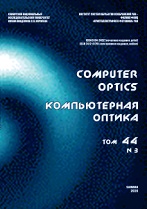|
OPTO-IT
Astigmatic transformation of a set of edge dislocations embedded in a Gaussian beam
V. V. Kotlyarab, A. A. Kovalevba, A. G. Nalimovba
a IPSI RAS – Branch of the FSRC "Crystallography and Photonics" RAS,
443001, Samara, Russia, Molodogvardeyskaya 151
b Samara National Research University, 443086, Samara, Russia, Moskovskoye Shosse 34
Abstract:
It is theoretically shown how a Gaussian beam with a finite number of parallel lines of intensity nulls (edge dislocations) is transformed using a cylindrical lens into a vortex beam that carries orbital angular momentum (OAM) and has a topological charge (TC). In the initial plane, this beam already carries OAM, but does not have TC, which appears as the beam propagates further in free space. Using an example of two parallel lines of intensity nulls symmetrically located relative to the origin, we show the dynamics of the formation of two intensity nulls at the double focal length: as the distance between the vertical lines of intensity nulls is being increased, two optical vortices are first formed on the horizontal axis, before converging to the origin and then diverging on the vertical axis. At any distance between the zero-intensity lines, the optical vortex has the topological charge TC=–2, which conserves at any on-axis distance, except the initial plane. When the distance between the zero-intensity lines changes, the OAM that the beam carries also changes. It can be negative, positive, and at a certain distance between the lines of intensity nulls OAM can be equal to zero. It is also shown that for an unlimited number of zero-intensity lines, a beam with finite OAM and an infinite TC is formed.
Keywords:
orbital angular momentum, topological charge, zero intensities, optical vortex.
Received: 11.12.2020
Accepted: 12.01.2021
Citation:
V. V. Kotlyar, A. A. Kovalev, A. G. Nalimov, “Astigmatic transformation of a set of edge dislocations embedded in a Gaussian beam”, Computer Optics, 45:2 (2021), 190–199
Linking options:
https://www.mathnet.ru/eng/co896 https://www.mathnet.ru/eng/co/v45/i2/p190
|

| Statistics & downloads: |
| Abstract page: | 77 | | Full-text PDF : | 22 | | References: | 17 |
|




 Contact us:
Contact us: Terms of Use
Terms of Use
 Registration to the website
Registration to the website Logotypes
Logotypes








 Citation in format
Citation in format 